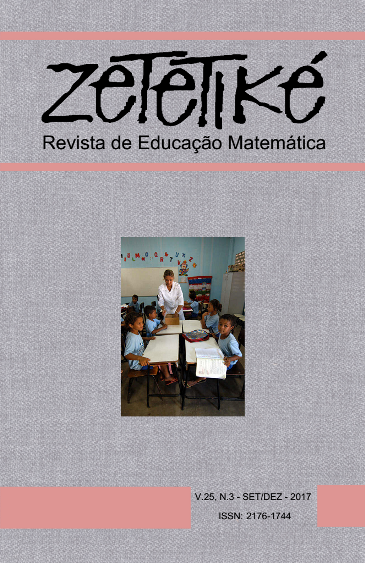Abstract
The study describes the didactic actions proposed by twelve mathematics teachers and twelve pre-service
teachers when facing errors on problems of multiplicative structure (product of measures and isomorphism of
measures) committed by elementary school students. It also examines if there is a relationship between the type
of didactic action proposed and the type of error identified. Each participant gave a semi-structured interview
and the data was audio recorded. Results show that teachers and pre-service teachers proposed a variety of
didactic actions; however, there are differences between both groups, which may vary quantitatively according
to the type of the problem. In addition, the few consistent signs of a relationship between the type of didactic
actions and the type of the identified errors may vary, not exclusively for the teachers’ training and their
experience, but also for some interaction between that variable with the type of problem. Implications for
teachers’ professional training are discussed.
References
Astolfi, J. P. (1999). El “error”, un medio para enseñar. Coleção “Investigación y Enseñanza”. Sevilha: Díada.
Bessot, A. (1980). Analyse d’erreurs dans 1’utilisation de la suite des nombres par les enfants de la 1ére. année de 1’énseignement obligatoire en France au cours préparatoire. In Proceedings of the International Congress on Mathematical Education, v. 4, (pp. 474-476). Berkeley/CA: ICME 5.
Borasi, R. (1996). Reconceiving mathematics instruction: a focus on errors. Norwood, NJ: Ablex Publishing Corporation.
Borba, R., Pessoa, C. & Rocha, C. (2012). How primary students and teachers reason about combinatorial problems. In ICMI-International Commission do MathematicalInstruction, (Ed.), 12th. International Congress of Mathematical Education: Pre-proceedings, (pp. 1795-1802). Seoul: ICMI.
Brousseau, G. (1998). Théorie des situations didactiques: didactique des mathématiques 1970-1990. Grenoble: La Pensée Sauvage.
Castro-Rodriguez, E., Rico, L. & Gómez, P. (2012). Meanings of fractions as demonstrated by future primary teachers in the initial phase of teacher education. In: ICMI-International Commission of Mathematical Instruction, (Ed.), 12th. International Congress of Mathematical Education: Pre-proceedings (pp. 1803-1810). Seoul: ICMI.
Chevallard, Y. (1985). La transposition didactique, du savoir savant au savoir enseigné. Grenoble: LaPensée Sauvage.
Contreras, L. C., Carrillo, J., Zakaryan, D., Muñoz-Catalán, M. C. & Cliemtn, N. (2012). Um estúdio exploratório sobre las competencias numéricas de los estudiantes para maestro. BOLEMA, Rio Claro, 26(42B), 433-457.
Cury, H. N. (1994). As concepções de matemática dos professores e suas formas de considerar os erros dos alunos. Tese de Doutorado em Educação. Porto Alegre: UFRGS, Faculdade de Educação.
Cury, H. N. (2007). Análise de erros: o que podemos aprender com as respostas dosalunos. Belo Horizonte: Autêntica.
Fischer, M. C. B. (2008). Os formadores de professores de matemática e suas práticas avaliativas. In W. R. Valente (Org.), Avaliação em Matemática :histórias e perspectivas atuais (pp.75-100). Campinas, SP: Papirus.
Gitirana, V., Campos, T, M. M., Magina, S. & Spinillo, A. (2014) Repensando Multiplicação e Divisão: Contribuições da Teoria dos Campos Conceituais. São Paulo: PROEM.
Koch, N. T. O. & Soares, M. T. C. (2005). O professor, seus alunos e a resolução de problemas de estrutura aditiva. In M. L. F. Moro & M. T. C. Soares (Orgs.), Desenhos, palavras e números: as marcas da matemática na escola (pp.145-182). Curitiba: Editora UFPR.
Lakatos, I. (1976). Pruebas y refutaciones: la logica del descubrimiento matemático. Madrid: Alianza Editorial.
Margolinas, C. (1993). De l’importance du vrai et du faux: dans la classe de mathématiques. Grenoble: La Pensée Sauvage.
Moro, M. L. F. & Soares, M. T. C. (2006). Aprendizagem de estruturas aditivas elementares- alunos, professores e pesquisadores como parceiros de uma construção conceitual. In M. R. F. de Brito (Org.), Solução de problemas e a matemática escolar (pp. 135-162). Campinas: Editora Alínea.
Pinto, N. B. (2000). O erro como estratégia didática: estudo do erro no ensino da matemática elementar. Campinas, SP: Papirus.
Spinillo, A. G., Pacheco, A. B. de, Gomes, J. F. & Cavalcanti, L. (2014). O erro no processo de ensino aprendizagem da matemática: errar é preciso? Boletim GEPEM (Online), 64, 1-12. Disponível em http://dx.doi.org/10.4322/gepem2015.005
Spinillo, A., Soares, M. T., Moro, M. L. F. & Lautert, S. F. (2016). Como professores e futuros professores interpretam erros de alunos ao resolverem problemas de estrutura multiplicativa? BOLEMA, 30(56), 1188-1206.
Vergnaud, G. (1983). Multiplicative structures. In R. Les & M. Landau (Eds.), Acquisiton of Mathematics: Concepts and Processes (pp.127-174). London: Academic Press.
Vergnaud, G. (1996). Au fond de l’action, la conceptualisation. In J.-M. Barbier (Dir.), Savoirs théoriques et savoirs d’action (pp. 275-292). Paris: PUF.
Vergnaud, G. (2014). A criança, a matemática e a realidade. M. L. F. Moro, trad. ed. revisada. Curitiba: Editora UFPR.

This work is licensed under a Creative Commons Attribution-NonCommercial-NoDerivatives 4.0 International License.
Copyright (c) 2017 Zetetike

